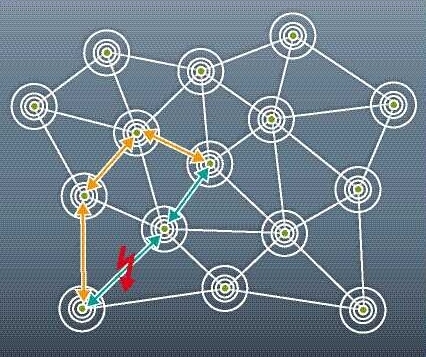WirelessHART
WirelessHART uses a 2.4 GHz band—license-free and used worldwide—as a transfer medium for several radio technologies, including WLAN, Bluetooth, and ZigBee. But, WirelessHART is much more than a WLAN variant.
WirelessHART uses a flat mesh network where all radio stations (field devices) form a network. Every participating station serves simultaneously as a signal source and a repeater. The original transmitter sends a message to its nearest neighbor, which passes the message on until the message reaches the base station and the actual receiver. In addition, alternative routes are set up in the initialization phase. If the message cannot be transmitted on a particular path, due to an obstacle or a defective receiver, the message is automatically passed to an alternative route. So, in addition to extending the range of the network, the flat mesh network provides redundant communication routes to increase reliability.
The communication in the Wireless Network is coordinated with TDMA (Time Division Multiple Access), which synchronizes the network participants in 10 ms timeframes. This enables a very reliable (collision-free) network, and reduces the lead and lag times during which a station must be active.
To avoid jamming, WirelessHART uses also FHSS (Frequency Hopping Spread Spectrum). All 15 channels as defined in IEEE802.15.4 are used in parallel; WirelessHART uses FHSS to “hop” across these channels. Channels that are already in use are blacked out to avoid collisions with other wireless communication systems.
The combination of 10s synchronization and 15 channels allows 1500 communications per second.

WirelessHART mesh network topology





 +49 621 776-0
+49 621 776-0